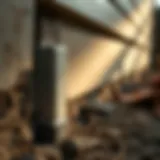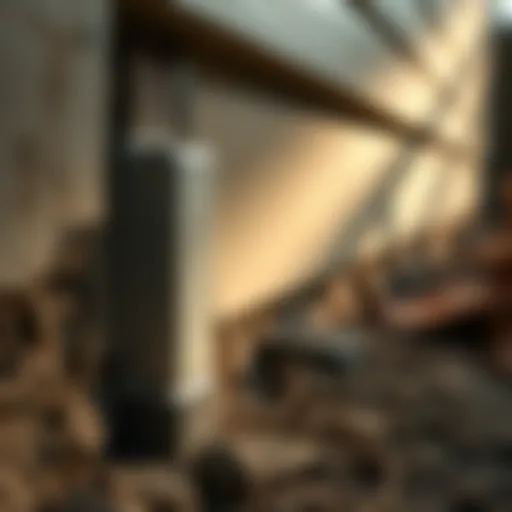Understanding Ants Inside Walls: Identification & Management
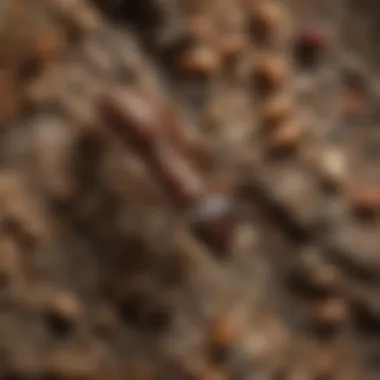

Intro
Ants are often viewed as innocuous, nature’s diligent workers. However, when these small insects find their way into the hidden spaces of your home, such as within wall cavities, they can pose significant risks. Understanding the behavior and characteristics of these pests is crucial for homeowners to effectively manage potential infestations. This article will guide you through identifying common ant species that may invade your walls, the implications of their presence for your property, and the various management strategies available to mitigate damage.
Pest Identification
Detailed Descriptions of Common Pests
Several ant species commonly invade the walls of homes. Each species has distinct behaviors and characteristics that aid in their identification.
- Carpenter Ants: Typically black or bicolored, these ants are larger than other household species. They prefer damp wood, making them a threat to wooden structures as they excavate nests.
- Odorous House Ants: These small, brown ants emit a unique odor when crushed, reminiscent of rotten coconut. They often form large colonies and are attracted to sweet foods.
- Pavement Ants: Found living under sidewalks and driveways, these ants are brown to black in color. They are known to invade homes in search of food, particularly greasy substances.
Signs and Symptoms of Infestations
Detecting an ant infestation can be subtle. However, certain signs can indicate their presence inside walls:
- Sightings: Seeing live ants, especially near baseboards or walls, is a primary indicator.
- Frass: Carpenter ants produce sawdust-like particles known as frass, which may be found beneath infested wood.
- Pheromone Trails: Ants leave pheromone trails to guide others to food sources, visible when observing numerous ants traveling the same path.
- Nesting Activity: Hollow sounds from wood or tiny holes in walls may suggest nesting behavior, especially for carpenter ants.
Prevention Strategies
Home Maintenance Tips for Pest Prevention
Effective prevention requires proactive home maintenance. Consider implementing the following steps:
- Seal Cracks and Crevices: Inspect areas around windows, doors, and pipes. Use caulk or expanding foam to seal gaps that may enable ant entry.
- Reduce Moisture Levels: Fix leaking pipes and ensure proper drainage to eliminate moisture that attracts carpenter ants.
- Maintain Cleanliness: Regularly clean kitchen surfaces to remove food scraps or spills that could attract ants.
Natural Deterrents and Barriers
A few natural remedies can help deter ants:
- Vinegar Solutions: Mixing equal parts vinegar and water can be effective for wiping surfaces to disrupt pheromone trails.
- Essential Oils: Using peppermint or tea tree oil can repel ants. Apply diluted oil along entry points.
- Diatomaceous Earth: Sprinkling this powder around affected areas can provide a physical barrier, dehydrating ants on contact.
Treatment Options
Overview of Chemical vs. Natural Treatments
When facing an infestation, you have various treatment options. Chemical treatments are potent but often come with health risks, while natural treatments offer safer alternatives. Choose based on your comfort and the severity of the infestation.
Step-by-Step Guides for DIY Treatments
For those opting for DIY solutions, several approaches can be effective:
- Boric Acid Bait: Mix boric acid with sugar water. Place the bait in areas where ants are seen. They will carry it back to their nest, targeting the colony.
- Peppermint Oil Spray: Combine 10 drops of peppermint oil with water in a spray bottle. Apply this in areas frequented by ants, as it interrupts their scent trails.
- Diatomaceous Earth Application: Spread food-grade diatomaceous earth around your home’s perimeter. It serves as a barrier against various pests without the use of harmful chemicals.
"Identifying the type of ant and understanding its behavior is the first step in effective management. Each species presents unique challenges and requires tailored methods of control."
The comprehensive understanding of ants within walls empowers homeowners to take preventive measures and employ suitable strategies for effective management. With this guidance, maintaining a pest-free home becomes a more achievable goal.
Prolusion to Ants Inside Walls
The presence of ants within wall spaces is a matter that deserves consideration, especially for homeowners. Ant infestations can lead to significant structural concerns and complications in maintaining a healthy living environment. This introduction aims to elucidate the importance of understanding the dynamics of ants hiding in walls, expanding on the specific elements such as identification, implications, and management strategies.
Ants are not merely a nuisance; they can impact a home's integrity. Individual ants may seem insignificant, but a colony inside the walls can cause extensive damage over time. Some species, like Carpenter Ants, actively compromise wooden structures, leading to deterioration. Paying attention to early signs of ant activity can prevent costly repairs later.
Ants are social insects that communicate and work collectively. Their behavior can alert homeowners to issues within their property.
Additionally, understanding the different species is critical. Visibility differs among ant types, and certain pests may indicate specific underlying problems, be it moisture or food sources. Homeowners can benefit from recognizing these signs, allowing them to take proactive measures.
This article also delves into the implications of ant infestations that extend beyond just structural risks. Often, infestations correlate with hygiene issues. For example, Sugar Ants are drawn to food sources and can create unsanitary conditions around the kitchen or pantry areas. Recognizing these connections is crucial for maintaining a clean and safe home environment.
Lastly, the management of an infestation involves a blend of prevention and treatment strategies. Knowledge about sealing entry points, managing food access, and treatment options can equip homeowners to handle these challenges effectively. This comprehensive understanding will not only aid in resolving current problems but will also minimize the chances of future infestations.
In summary, understanding ants inside walls is vital for maintaining structural integrity, ensuring hygiene, and implementing effective pest management strategies.
Common Ant Species Found in Walls
Understanding the common ant species that reside within walls is crucial for homeowners seeking to manage potential infestations effectively. Recognizing various species can provide insight into their behavior, nesting practices, and the risks they pose to property integrity. Each ant species exhibits distinctive traits, influencing how they interact with their surroundings and the level of threat they might present. For instance, carpenter ants are notorious for their wood-destroying habits, while sugar ants are drawn to food sources, often in kitchens. Knowledge of specific species aids in tailoring management strategies to mitigate risks rather than adopting generic solutions that might not address the real issues at hand.
Carpenter Ants
Identification
Identifying carpenter ants is pivotal for effective management. They are typically large, ranging from 0.25 to 1 inch in length, and have a black or bicolored appearance. Their smooth, rounded bodies have no significant segmentation, which differentiates them from termites. Recognizing these traits allows homeowners to take the necessary steps before the infestation escalates. Notably, carpenter ants are often confused with other ant species, so understanding their specific characteristics is a beneficial choice for this article. Their distinctive physical features enable homeowners to easily identify signs of their presence before significant damage occurs.
Nesting Habits
Carpenter ants prefer to nest in moist, decaying wood but can also inhabit insulated areas within walls. Their nesting habits often lead them to unseen locations in homes, making early detection challenging. They typically excavate wood to create galleries rather than consuming it. This behavior is critical to understanding how they develop nests and expand colonies, directly impacting the structural integrity of homes. Awareness of where and how these ants create their nests helps in taking proactive measures against potential damage.
Impact on Structures
The impact carpenter ants may have on a building's structure can be substantial. While they do not consume wood like termites, their tunneling can weaken support beams and wooden structures. This specific aspect of their behavior poses a substantial risk to the integrity of homes. Households affected by carpenter ants might experience costly repairs if the infested areas go unnoticed for too long. Proper identification and monitoring are advantageous for preventing extensive damage.
Sugar Ants
Identification
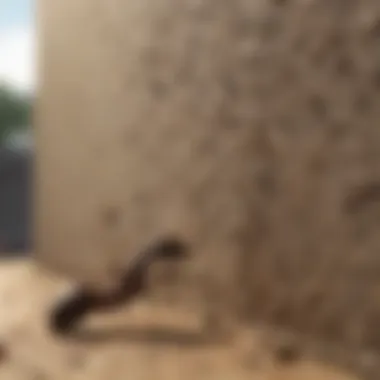
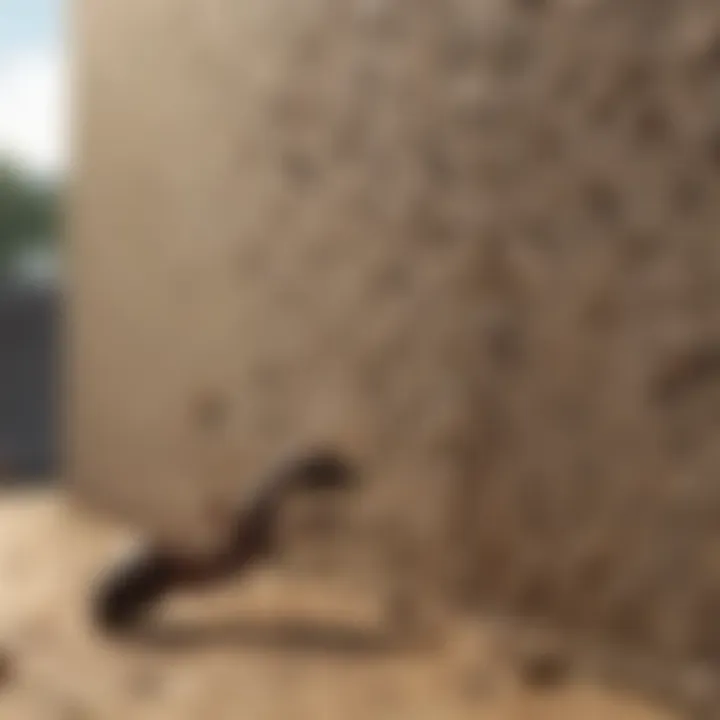
Sugar ants, or Camponotus consobrinus, are small with a size roughly 0.2 to 0.5 inches in length. They often exhibit a shiny, black or brown appearance. Their distinctively slender bodies and longer legs make them fairly recognizable. Their identification is essential because their presence often indicates food sources. Understanding the nuances of sugar ant identification supports accurate assessment and intervention, ensuring immediate action is taken when these ants are spotted.
Feeding Preferences
Sugar ants are particularly attracted to sugary substances, including nectar, fruits, and spills in homes. Their feeding preferences dictate their foraging behavior, leading them into kitchens and food-storage areas. This characteristic plays a significant role in attracting them toward human habitats. As such, by recognizing their feeding habits, homeowners can implement necessary measures to secure food sources and minimize potential infestations.
Behavioral Traits
The behavior of sugar ants is characterized by their strong foraging capabilities and social nature. They communicate and collaborate to locate food, which can lead to rapid population growth in favorable conditions. Their distinctive behavioral traits make them particularly adept at locating sources of nourishment. Understanding these traits underscores the importance of maintaining cleanliness and securing potential food sources in the home, minimizing the likelihood of attracting them.
Pavement Ants
Identification
Pavement ants, measuring around 0.1 to 0.2 inches in length, often present dark brown or black coloring. Their identification is crucial as they tend to be overlooked due to their small size. Pavement ants have a rugged appearance characterized by noticeable striations on their bodies. Recognizing these physical traits helps in determining their presence, paving the way for effective management strategies.
Nesting Locations
Pavement ants prefer nesting under sidewalks, stones, or within the cracks of pavement. In residential areas, their nests often appear as small mounds of soil. Understanding their nesting locations informs homeowners about the best strategies for reducing infestations. It also provides valuable information about what outdoor environments may contribute to their entry into homes.
Activity Patterns
Pavement ants show notable activity during warmer months, particularly in spring and summer when they are foraging for food. Understanding their activity patterns aids homeowners in managing their property during peak ant activity times. This knowledge can promote proactive measures in conjunction with seasonal changes, such as more thorough cleanups and preventive barriers to seal potential entry points.
Signs of Ant Infestation in Walls
Recognizing the signs of ant infestation in walls is crucial for homeowners. Early detection helps to mitigate the potential damage these pests can cause. It is important to understand these signs so you can act quickly. Ignoring them may lead to more significant issues, such as structural damage or health concerns.
Visual Indicators
Foraging Trails
Foraging trails are one of the most telling signs of an ant infestation. Ants establish routes to food sources, and these trails are often visible as ants march in a line. The key characteristic of foraging trails is their consistency. A visible trail can indicate the presence of a colony nearby. Additionally, recognizing these trails makes it easier to pinpoint the ants' source and the entry points into your home. This is a beneficial aspect of identifying an infestation.
Sawdust Accumulation
Sawdust accumulation is a specific indicator, especially in the case of carpenter ants. These ants chew through wood to create nests, leaving behind piles of sawdust. The unique feature of sawdust is its often distinctive appearance. It can be mixed with fecal matter, which looks like small black pellets. The presence of sawdust directly indicates that an active nest may be nearby. This aspect is particularly important as it shows structural risk from wood damage.
Worker Ants Presence
The presence of worker ants is another telling sign. Worker ants are visible as they leave the nest in search of food. Their presence in unusual places, such as inside walls, can indicate an established colony. Observing these ants can help in understanding the extent of the infestation. A key characteristic is their behavior; they often carry food back to the nest, making it easier to trace the nest location. However, one must differentiate between active individuals and those merely exploring.
Structural Damage
Hollow Sounds
Hollow sounds within walls are often a warning signal of ant infestations. When tapping on walls, if you hear a hollow sound, it may suggest that ants are creating hollow areas in the wood. This is a significant red flag as it indicates possible structural weaknesses. Such a sound is a unique feature that draws attention to potential interior damage. Identifying these sounds can facilitate early intervention to prevent further damage.
Visible Holes
Visible holes in walls can indicate an ant problem, especially with gnawing species like carpenter ants. These holes may appear small but can expand over time as the infestation grows. The unique feature of visible holes is that they not only indicate a problem but also serve as entry points for more ants. Recognizing these holes early can lead to preventive measures to stop further incursions into the home.
Weakened Framework
A weakened framework is a serious concern. Ants can compromise the structural integrity of walls and beams through their nesting habits. The key characteristic is that this damage often goes unnoticed until it becomes severe. A weakened framework poses risks not only to the house's integrity but also to the safety of its occupants. Detecting signs of weakness can help in taking immediate action before escalation.
Paying attention to these signs can save homeowners from costly repairs and extended pest problems.
Why Ants Enter Walls
Understanding why ants enter walls is vital for homeowners and property managers. An ant infestation often signifies deeper issues within a structure. Identifying these motivations helps in tailoring effective management strategies.
Ants seek shelter and resources. The wall spaces of a home provide safe locations for nesting and easy access to food. By exploring factors like food sources and nesting preferences, we can learn how to prevent and address potential infestations.
Food Sources
Attraction to Sugars
Ants, particularly species like sugar ants, have a strong attraction to sugary substances. This predisposition draws them into walls. Sugar sources can include spilled food, hidden sweets, or fermenting fruit. Such sugary attractants not only lure ants but also allow them to thrive and reproduce within the confines of walls.
The key characteristic of sugar attraction is its universality. Nearly all ant species will seek out sugary resources, making it an impactful consideration for pest control. The unique feature here is the ease with which sweets can originate from common household activities. This connection between household habits and ant behavior highlights the advantages of maintaining cleanliness and proper food storage solutions.
Access to Unsealed Food
Ants can access unsealed food that may be stored in pantries or on countertops. This access acts as an open invitation for them to invade homes. An unsealed bag of dog food or an uncovered bowl of fruit sets up a perfect condition for ants to explore and nest. The risk significantly increases when food is easily reachable.
The characteristically easy access is a critical driving factor for infestations. This situation emphasizes the need for homeowners to seal food securely. However, it can also present a disadvantage when people are unaware of their existing food conditions. Not recognizing how household habits create vulnerabilities can lead to bigger infestations
Nesting Preferences
Temperature Regulation
Ants prefer stable temperatures when selecting nesting locations. The interior of walls can offer a regulated environment that protects them from external fluctuations. This stable microclimate promotes their survival and reproduction.
The importance of temperature regulation lies in its substantial impact on ant behavior. A regulated environment represents an attractive choice for ant colonies. Such conditions can provide enhanced shelter from changing weather, making wall spaces even more appealing.
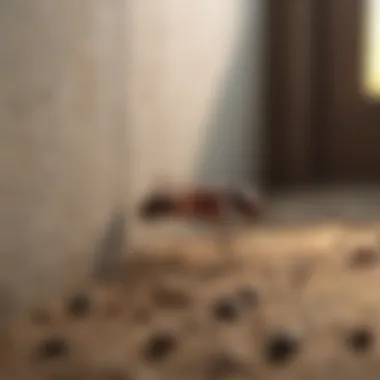
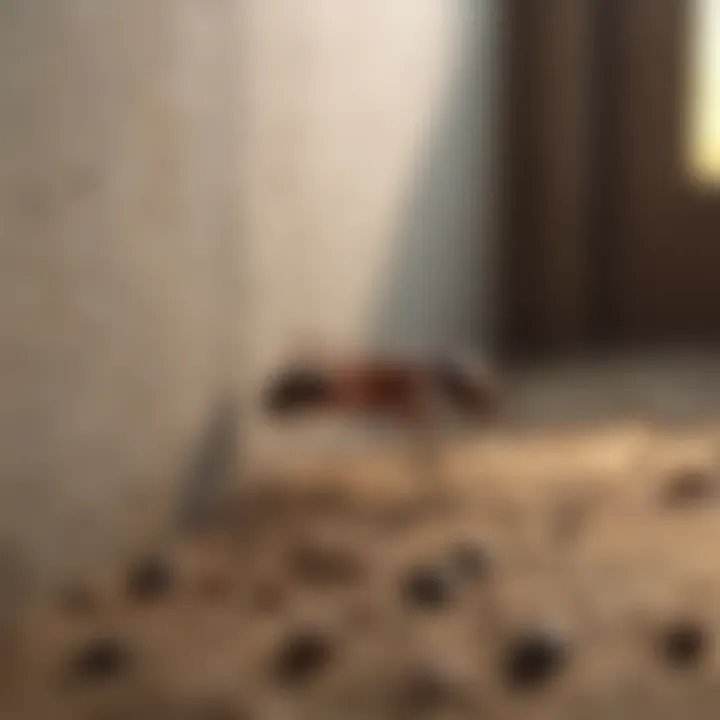
Protection from Predators
Nesting within walls offers ants protection from various predators. Many animals naturally prey on ants. Walls provide a safe haven where they can avoid potential threats.
The critical aspect of protection is that it ensures survival for ant colonies. By ensuring minimal external threats, they can flourish unnoticed. For homeowners, acknowledging this tendency underlines the importance of vigilance to prevent infestations. This awareness allows for proactive measures, reducing the likelihood that ants will take up residence inside the home.
Impact of Ants on Home Integrity
Understanding how ants affect home integrity is crucial for homeowners. Ants are more than just a nuisance. Their presence can signal structural risks and health concerns that may escalate over time if not addressed.
Structural Risks
Potential for Wood Damage
Carpenter ants pose a significant risk when they infest homes. They dig through wood to create nests, leading to potential damage that can undermine wood frameworks. This type of damage can be subtle at first, making it easy to overlook. Over time, the structural integrity of affected areas can deteriorate, causing costly repairs. This damage often remains hidden until it is too late, making awareness and preventive measures vital.
The ability of carpenter ants to affect wood is one reason they are commonly misunderstood. Most people think of ants as small, harmless creatures, but these particular ants can weaken beams and joists, leading to severe consequences. In this discussion, it is clear that ignoring signs of carpenter ants is reckless. The long-term implications can lead to expensive fix and even safety issues in the home.
Compromised Insulation
Insulation is a key component of any home, providing temperature regulation and energy efficiency. When ants invade walls and nests are established, insulation can become compromised. Ants can disturb insulation materials, reducing their effectiveness. This disturbance can lead to higher energy bills as heating and cooling systems must work harder to maintain comfortable temperatures.
The impact of compromised insulation goes beyond energy costs. It can also create an environment conducive to other pests or mold growth. Homeowners must be aware of this risk, as the presence of ants may indicate other underlying issues that require attention. Not addressing ant infestations can create a cycle of problems that extend beyond mere annoyance.
Health Concerns
Allergies
Certain species of ants can trigger allergic reactions in sensitive individuals. The presence of ants in the home can lead to an increase in the risk of developing allergies. People may develop reactions to ant bites or irritation from the pheromones these insects release. Awareness of this risk is important, particularly for households with children or vulnerable family members.
Understanding how ant activities can lead to allergic reactions is a key consideration for homeowners. If ants invade living spaces, the likelihood of such issues increases. Thus, being proactive about ant control can promote a healthier home environment.
Hygiene Issues
Ants are often attracted to food sources, and their presence can compromise hygiene in the home. They can carry bacteria from outdoor environments, introducing potential health hazards. This contamination risk extends to food areas, where ants may invade kitchens and pantries. Maintaining hygiene becomes critical to avoid possible foodborne illnesses.
The dual threat of health concerns and hygiene issues underscores the importance of ant management strategies. An infestation can lead to increased anxiety and a sense of discomfort in one’s living space. Understanding these implications helps in prioritizing preventive actions against ants.
"Addressing ants in your walls is not just about pest control; it's about preserving the health and safety of your home."
Preventative Measures Against Ant Infestations
Preventing ant infestations is crucial for maintaining the integrity and comfort of your home. Understanding and implementing effective measures can help deter ants from entering and establishing colonies within wall spaces. Prevention is generally more efficient and less costly than dealing with the consequences of an infestation after it occurs. Several strategies focus on sealing potential entry points and decluttering areas to minimize attractants.
Sealing Entry Points
Chimneys
Chimneys are significant access points for ants seeking entry into homes. Many homeowners overlook this area. The design of chimneys can allow ants to move in from the outside, especially if there are gaps around the flue or chimney cap. Sealing these entry points prevents ants and other pests from taking advantage of the warmth and protection that chimneys provide. The key characteristic of sealing chimneys is its effectiveness, as a small investment in proper sealing can protect your entire home. This solution is beneficial because it is relatively straightforward and often uses methods such as caulking and screens to block access.
However, one must consider that sealing may not be an immediate fix if an infestation is already present. If the issue persists, further inspection of the chimney structure may be necessary.
Vents
Vents, similar to chimneys, can become entry points for ants. These openings are designed to allow air circulation but can also attract pests if not properly secured. A well-maintained ventilation system is essential, as even a small gap can be a gateway for ants to infiltrate walls. The key characteristic of addressing vents is the importance of ensuring screens fit securely and inspecting them regularly for wear and tear. This prevention measure is popular among homeowners because it both improves air quality and deters pests.
When considering this option, remember that vents are often hard to monitor for damage. Regular maintenance helps to identify issues before they become significant problems.
Cracks and Gaps
Cracks and gaps in walls or foundations provide numerous entry points for ants. These imperfections may be small but can lead to bigger problems. Sealing cracks is not merely a cosmetic fix. It is a fundamental step toward maintaining home integrity and preventing infestations. Fillers and sealants can effectively close these gaps, making it difficult for ants to gain access.
The unique feature of addressing cracks and gaps is its wide-ranging application. This approach not only helps with ant control but improves energy efficiency by reducing air leaks. However, the disadvantages include that it might require a thorough inspection and possibly professional assessment to find and remedy all potential openings.
Decluttering Areas
Eliminating Food Sources
One of the most effective strategies in preventing ant infestations is eliminating food sources. Ants are predominantly motivated by nourishment. Keeping food sealed and stored in airtight containers greatly reduces the likelihood of attracting ants into the home. This simple step helps homeowners to proactively control their living spaces. The key characteristic here is a focused approach to kitchen and pantry maintenance, ensuring that no accessible food remains.
This choice is beneficial because it requires minimal cost while delivering high rewards in ant control. However, it may involve changing established habits, which can be challenging for some.
Reducing Nesting Sites
Reducing nesting sites is another critical measure against ant infestations. Ants thrive in areas with moisture and shelter. Keeping indoor spaces dry and clutter-free minimizes potential nesting grounds. This includes eliminating cardboard boxes and piles of laundry that can attract ants. The key characteristic of this step is its preventive nature, decreasing the chances for ants to find safe spaces to breed and live.
This measure is popular because it contributes to a cleaner and healthier living environment. However, the challenge lies in the ongoing requirement to maintain these spaces regularly to ensure that nests do not form again.
Treatment Options for Existing Infestations
Addressing ant infestations within walls is critical for maintaining the integrity of a home. Effective treatment options can significantly reduce the presence of ants and prevent further damage. Knowledge of various treatments allows homeowners to take informed decisions that best suit their situation and resources.
Chemical Solutions
Insecticide Sprays
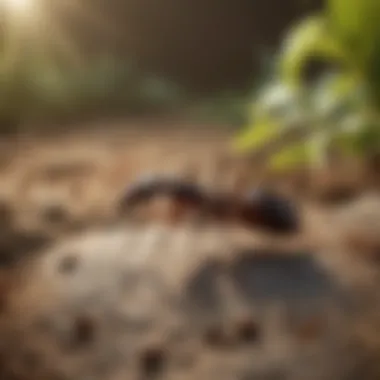

Insecticide sprays are a common method for managing ant populations within walls. They deliver a direct solution to the infestation issue. One defining characteristic of insecticide sprays is their immediate effectiveness, quickly killing ants upon contact. This makes them a popular choice for those seeking rapid results.
The unique feature of these sprays often lies in their ease of application. Many can be used in hard-to-reach areas or crevices within walls. However, there are disadvantages to consider. Some insecticide sprays might not eliminate the entire colony, especially if the nest is located deeper within structural elements. Additionally, concerns about residue and toxicity to humans and pets should not be overlooked.
Baiting Systems
Baiting systems provide another method to control existing ant infestations. This approach uses attractants combined with slow-acting poison, targeting worker ants who carry the bait back to the colony. A key characteristic of baiting systems is their focus on eliminating the entire colony rather than just individual ants. This is crucial for long-term management, as it can effectively reduce the ant population over time.
The unique feature of baiting systems is their ability to work even when the source of food is not accessible. Ants are naturally drawn to the bait, which means they are likely to consume it. A disadvantage, however, is the time it takes for the bait to show results. Unlike direct sprays, expecting immediate relief might lead to frustration.
Professional Treatments
When infestations are severe, homeowners may consider professional treatments. Pest control professionals bring expertise and specialized tools to manage ant populations more effectively than typical home remedies. A key benefit of professional treatments is the comprehensive analysis of the situation, enabling tailored solutions based on the specific type of ant and severity of the infestation.
The unique advantage of hiring professionals is their access to strong, often more effective products that may not be available to the general public. They can identify nesting spots and apply treatments accordingly. However, the potential downside includes the associated costs, which can be significant for some homeowners. Moreover, there may be a need for follow-up visits, particularly for severe infestations.
Natural Remedies
Diatomaceous Earth
Diatomaceous earth is an intriguing natural remedy for ant infestations. This powdery substance consists of fossilized algae, rendering it safe for human use while lethal to insects. Its key characteristic is its abrasive quality, which damages the exoskeletons of ants upon contact. This method is favored for its non-toxic nature, making it suitable for households with children and pets.
The unique feature of diatomaceous earth is that it can be applied around entry points and nesting areas. Ants carry the powder back to their colonies, providing additional effectiveness. Nevertheless, homeowners should be aware that diatomaceous earth may need to be reapplied after rain or cleaning, as moisture can diminish its effectiveness.
Essential Oils
Essential oils, such as peppermint and tea tree oil, offer a fragrant alternative to conventional treatments. The key characteristic of these oils is their strong scent, which can deter ants when used in sprays or diffusers. This type of solution is appreciated for its pleasant aroma and natural origin.
The unique feature of essential oils is their versatility. They can be mixed with water and used for both deterrence and cleaning. However, these solutions may not be as effective against established colonies. Frequent application may also be necessary to maintain effectiveness, which can require effort and time for the homeowner.
Vinegar Solutions
Vinegar is a simple yet effective solution for managing ant problems. The primary characteristic of vinegar solutions is their ability to disrupt ant trails, making it difficult for ants to navigate and communicate. A common ratio used is equal parts water and vinegar in a spray bottle.
The unique benefit of vinegar solutions is their ease of use. Homeowners can spray the mixture in areas where ants are seen and around potential entry points. However, similar to essential oils, vinegar might not kill ants directly but can greatly assist in deterring them. Regular application is often necessary to maintain effectiveness, which requires diligence from the homeowner.
Understanding the treatment options available for ant infestations can empower homeowners to take appropriate actions to safeguard their properties. Choosing the right method depends on various factors, including the severity of the infestation, safety considerations, and available resources.
When to Seek Professional Help
Recognizing the right moment to engage professional pest control services is crucial in managing ant infestations inside walls. This decision often hinges on various factors, including the severity of the infestation and the resultant damage observed in the structure. Homeowners can greatly benefit from understanding specific signs that indicate when it is time to consult experts.
Evaluating Severity
Persistent Infestation
A persistent infestation refers to a situation where ant activity continues over time and seems to worsen despite measures taken to address it. The key characteristic of a persistent infestation is that homeowners often notice a lack of effectiveness in DIY or over-the-counter treatments. This point underscores the necessity of professional intervention. Persistent infestations can lead to more extensive damage, as colonies grow and become more aggressive in their search for food.
Symptoms include consistent ant visibility, especially during warmer months, and repeated reappearance after treatment. It is critical for homeowners to realize that ignoring signs of persistent infestation can result in greater structural issues and increased repair costs later.
Structural Damage Observed
Structural damage observed in the home is another serious aspect that often necessitates professional help. When ants invade, they often compromise the integrity of wooden structures, insulation, and other critical components of the home. This damage may not be immediately visible, making it essential to evaluate areas near the walls for signs of deterioration. A key characteristic here is the potential for unseen damage to grow to a point where it poses safety risks, such as the risk of collapse in severe cases.
Homeowners should be vigilant for indicators such as soft spots in walls, hollow sounds when tapping on wood, or visible frass, which looks like sawdust. Recognizing structural damage early helps in formulating a plan for remediation and could potentially save costs and stress related to extensive repairs.
Choosing a Pest Control Service
When considering pest control services, several factors should be weighed to ensure effective remediation. Choosing the right service can significantly influence the outcome of the ant problem.
Certifications
Certifications from recognized pest control associations signify that a service follows industry standards. This is essential as certified professionals are typically trained to handle infestations safely and effectively. A key characteristic of certified services is their commitment to continuous education and adherence to regulations within the pest control industry.
Having certified professionals may also provide peace of mind to homeowners, knowing that they are paying for a service that meets specific quality benchmarks. However, not all certifications are equal, and homeowners should verify the credibility of the issuing body before opting for a service.
Experience
Experience is another critical factor when selecting a pest control service. Companies with a proven track record in handling ant infestations can offer practical insights and effective solutions that newer companies may lack. Experienced professionals can diagnose issues accurately and suggest appropriate prevention methods based on historical data.
Homeowners should inquire about the length of time a company has been in business and the results they have achieved in the past. This depth of experience often translates into faster, more reliable service which minimises stress and disruption at home.
Service Options
Lastly, the range of service options offered by pest control companies can provide further insight into their competency. Some companies might specialize exclusively in chemical treatments, while others may offer integrated pest management that includes environmental and natural solutions. Offering various approaches demonstrates a company's flexibility and knowledge in dealing with diverse ant issues.
It is beneficial for homeowners to inquire about all available service options, ensuring they select a method that aligns with personal preferences and health considerations, especially if they have children or pets at home.
Finale
In understanding the complexities of ants inhabiting walls, we acknowledge significant aspects of identification, implications, and management. The conclusion serves as a critical reflection on the interconnected elements discussed throughout this article. Homeowners and housewives alike should grasp that recognizing the presence of ants is not merely about spotting them but understanding their behaviors and establishing effective management strategies.
One of the primary benefits of this knowledge is the ability to prevent potential infestations. By identifying certain species like carpenter ants or sugar ants, individuals can tailor their approaches to deter these pests effectively. The insights on nesting habits, for instance, allow for informed decision-making regarding home maintenance and pest control interventions.
Furthermore, this article highlights the implications of infestations on property integrity. Structural damage from ants, especially those that excavate wood, can lead to serious, costly repairs. Awareness of these risks fortifies the motivation for adequate prevention and intervention measures.
When addressing an existing problem, the provided management strategies—from chemical treatments to natural remedies—empower individuals with choices. Understanding that this is not a one-size-fits-all scenario encourages a strategic approach to pest control. Homeowners can assess their situation, selecting methods appropriate for their specific context and preferences.
Finally, the emphasis on seeking professional help when necessary cannot be understated. This reinforces the need for a thorough evaluation of one’s environment before taking action. In some cases, the expertise of pest control professionals may be indispensable to resolve persistent infestations or significant damage.
"A proactive approach is key to maintaining a pest-free home environment."
In summary, the exploration of ants inside walls is not just about the insects themselves but encompasses broader considerations for homeowners. By synthesizing the information presented, we hope to equip readers with the essential tools and insights to manage this often-overlooked aspect of home maintenance.
